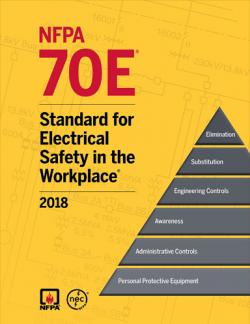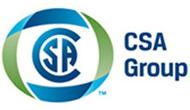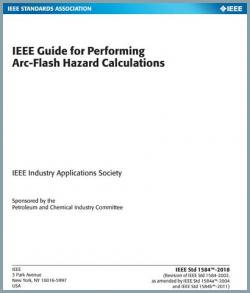
Overview
There are several standards and codes that provide a lot of guidance for providing a workplace that minimizes the risk of electrical hazards. The following codes and standards are some of the most commonly consulted documents on the arc flash topic. The coverage below is to provide awareness of the types of guidance available to industry.
NFPA 70E Standard

The first several editions of the standard, originally titled "Standard for Electrical Safety Requirements for Employee Workplaces," primarily focused on the prevention of electrocution. In the 1995 edition, arc flash hazards started to be addressed with addition of "arc flash hazard boundaries." Through extensive work, more details on protecting workers against arc flash hazards have been included in subsequent editions.
The last two editions have significantly improved the coverage of risk management concepts. With the inclusion of the risk control pyramid of ANSI Z10 (shown on the cover of the 2018 edition), employers are being directed to lower risks by considering options from the more effective methods at the top of the pyramid. See [LINKS to Section 4 & 6]
Currently NFPA 70E is organized into four chapters and a series of annexes designed to provide guidance on how to implement various aspects of an electrical safety program:
- Chapter 1: Safety Related Work Practices
- Chapter 2: Safety Related Maintenance Requirements
- Chapter 3: Safety Requirements for Special Equipment
- Annexes A-Q
Chapter 1 outlines the requirements of employers whose employees are to work on equipment that has not been placed into an "electrically safe work condition." One of these requirements is to perform an arc flash risk assessment, which enables the employer to determine the magnitude of the arc flash hazard, the likelihood of injury and what protective measures are needed such as the type of PPE needed. [Link to Section 5 Hazard Analysis]
The Safety Related Work Practices chapter of NFPA 70E also provides guidelines for:
- Developing safety-related work practices, including:
- A safety program with defined responsibilities
- Training for workers
- Establishing electrically safe work conditions
- Working involving electrical hazards, including:
- Performing electrical hazard and flash hazard analyses
- Selecting personal protective equipment (PPE) for workers
CSA Standard CSA-Z462

As a result of recent developments involving issues with arc flash in Canada, CSA has formed a committee to create a Canadian standard — designated CSA-Z462, Standard on Workplace Electrical Safety — to be effective in 2008.
Based on an agreement with the NFPA, the CSA will be using NFPA 70E as the "seed document" for the development of CSA-Z462. The intent is to harmonize both documents as much as practicable for Canadian workplaces.
In response to requests from Canadian industry for a simple summary of the direction and purpose of CSA-Z462, the CSA has created a fact sheet. For additional information, go to the CSA website.
IEEE Standard 1584-2018

As implied by its title, Guide for Performing Arc Flash Hazard Calculations, IEEE Standard 1584 provides techniques for designers and facility operators to apply in determining the arc flash-protection boundary and arc flash incident energy for PPE selection.
The recently released 2018 edition contains extensive changes in the calculation model that could yield dramatic differences to incident energy calculations from previous analyses. The challenges in applying the new model including selecting electrode configuration are covered more extensively in [Section 3 and 5].
NFPA 70, National Electrical Code®
While the National Electrical Code (NEC) has traditionally addressed proper installation techniques intended to prevent fire, electrocution and shock hazard, it now contains requirements related to arc flash hazards.
Section 110-16, Flash Hazard Warning, requires markings on switchboards, panelboards, industrial control panels and motor control centers to warn qualified persons of potential arc flash hazards.
Inadequate short circuit ratings (both AIR and SCCR) are on the list of causes of arc flash events. Over the past several cycles the NEC has added and modified sections to more effectively address this issue. The first step in properly selecting adequate short circuit ratings is to know the available fault current. The following sections now call for proper field labeling of equipment with the maximum short circuit current available at the line terminals of that equipment:
- 110.16 (B) Service Equipment
- 110.24 Field Markings
- 430.99 MCC
- 409.22 Industrial Control Panels
- 670.5 (2) Industrial Machinery
It is now clear in Article 409 and 670, that equipment installed under these sections must have a SCCR and or available fault current greater than the maximum available fault current at their location and have the equipment SCCR marked by the manufacturer. It is the end user and/or installer’s responsibility to properly specify the needed short circuit performance required. [Link to Tech Topic]
OSHA (Occupational Safety and Health Administration)

OSHA regulations were developed to mandate that employers provide a safe workplace for their employees. The following sections of standard CFR Part 1910 promote the safety of employees working on or near electrical equipment, and clearly define employers' responsibilities:
Equipment must be deenergized before work is performed!
In addressing work on electrical equipment, 1910.333(a)(1) states:
Live parts to which an employee may be exposed shall be deenergized before the employee works on or near them, unless the employer can demonstrate that deenergizing introduces additional or increased hazards or is infeasible due to equipment design or operational limitations. Live parts that operate at less than 50 volts to ground need not be deenergized if there will be no increased exposure to electrical burns or to explosion due to electric arcs.(this was added)
Note 1: Examples of increased or additional hazards include interruption of life support equipment, deactivation of emergency alarm systems, shutdown of hazardous location ventilation equipment, or removal of illumination for an area.
Note 2: Examples of work that may be performed on or near energized circuit parts because of infeasibility due to equipment design or operational limitations include testing of electric circuits that can only be performed with the circuit energized and work on circuits that form an integral part of a continuous industrial process in a chemical plant that would otherwise need to be completely shut down in order to permit work on one circuit or piece of equipment.
Note 3: Work on or near deenergized parts is covered by paragraph (b) of this section.
https://www.osha.gov/laws-regs/regulations/standardnumber/1910/1910.333
Lockout/tagout procedures must be used
In Note 2 of 1910.333(b)(2), it states:
Lockout and tagging procedures that comply with paragraphs (c) through (f) of 29 CFR Part 1910.147 will also be deemed to comply with paragraph (b)(2) of this section, provided that:
[1] The procedures address the electrical safety hazards covered by
this Subpart; and
[2] The procedures also incorporate the requirements of paragraphs
(b)(2)(iii)(D) and (b)(2)(iv)(B) of this section
If equipment cannot be deenergized prior to work:
Employees must be properly protected
When employees are required to work where there is a potential electrical hazard, 29 CFR Part 1910.335 calls for the employer to provide:
...electrical protective equipment that is appropriate for the specific parts of the body to be protected and for the work to be performed.
The appendix to Part 1910 Subpart S references NFPA 70E as providing information that "can be helpful in understanding and complying with the requirements contained in Subpart S."
Employers are responsible for performing a hazard assessment. 29 CFR Part 1910.132(d)(1), hazard assessment and equipment selection, states:
The employer shall assess the workplace to determine if hazards are present, or are likely to be present, which necessitate the use of personal protective equipment (PPE). If such hazards are present, or likely to be present, the employer shall:
- Select, and have each affected employee use, the types of PPE that will protect the affected employee from the hazards identified in the hazard assessment (1910.132(d)(1)(i));
- Communicate selection decisions to each affected employee (1910.132(d)(1)(ii)); and,
- Select PPE that properly fits each affected employee (1910.132(d)(1)(iii)).
This is the section referred to in the OSHA standard interpretation that discusses NFPA 70E. The remainder of 1910.132 outlines the requirements for the design, application, proper selection, training and documentation required for the use of personal protective equipment.
Other OSHA Regulations Relating to Arc Flash Hazards
OSHA 29 CFR Part 1910 contains many other sections that pertain to electrical safety and arc flash hazards:
- Subpart S: Paragraphs 1910.301 to 1910.399 address electrical safety requirements, particularly sections 1910.331 through 1910.335, which concern electrical safety work practices
- Subpart I: Paragraphs 1910.132 to 1910.139 cover personal protective equipment
- Subpart J: Paragraphs 1910.141 through 1910.147 discuss general environmental controls, including lockout/tagout
In addition, 29 CFR Part 1926, Safety and Health Regulations for Construction, Subpart K, contains requirements for electrical safety in paragraphs 1926.400 through 1926.449.
NFPA 70E and OSHA
OSHA standards don't provide details on how to conduct an electrical hazard assessment or how to select PPE. For guidance on compliance, you need to look to national consensus standards.
NFPA 70E is one of the foremost consensus standards for electrical safety. It covers employee protection from the electrical hazards of shock, arc flash, and arc blasts.
Although it is only referenced in OSHA 29 CFR Part 1910 Subpart S, Appendix A, NFPA 70E is considered by OSHA to be the recognized industry practice for electrical safety.
In its standard interpretation of the relevance of NFPA 70E, OSHA states:
… industry consensus standards, such as NFPA 70E, can be used by OSHA and employers as guides in making hazard analyses and selecting control measures.
From the Overview on electrical in OSHA: https://www.osha.gov/SLTC/electrical/hazards.html
- Working with electricity can be dangerous. Engineers, electricians, and other professionals work with electricity directly, including working on overhead lines, cable harnesses, and circuit assemblies. Others, such as office workers and sales people, work with electricity indirectly and may also be exposed to electrical hazards. Electricity has long been recognized as a serious workplace hazard. OSHA's electrical standards are designed to protect employees exposed to dangers such as electric shock, electrocution, fires, and explosions.
- Many workers are unaware of the potential electrical hazards present in their work environment, which makes them more vulnerable to the danger of electrocution. According to 29 CFR 1926.21(b)(2), "The employer shall instruct each employee in the recognition and avoidance of unsafe conditions and the regulations applicable to his work environment to control or eliminate any hazards or other exposure to illness or injury." The following references aid in recognizing hazards associated with electrical work.
And while the current edition of NFPA 70E emphasizes that energized electrical conductors and circuit parts be placed in an electrically safe work condition, it contains extensive requirements for workers who “are exposed to electrical hazards from electrical conductors or circuit parts that are or can become energized." When such work is to be performed, the required electrical hazard analysis has specific requirements for analysis of shock and flash hazards. Other sections provide guidance on selecting the proper PPE.
In recent additions, 70E has provided additional guidance on managing the risk associated with the arc flash hazard. Click here for more details on Managing The Risk Associated Arc Flash [NEED LINK TO MAIN PAGE OF 6_MANAGING THE RISK]
Other Regulations for Protecting Workers From Arc Flash Hazards
Personnel responsible for electrical safety should stay up to date on all relevant consensus standards. Here are other industry standards that address electrical safety as it applies to arc flash hazards:
